A herbaceous perennial plant shallots (Allium ascalonicum), also called shallots, Old Believers, bush, family onions, Ashkelon onions, charlotte, shrike, or bush, is a representative of the Onion family. The homeland of this type of onion is Asia Minor, but today it is widespread in Moldova, Western Europe, Ukraine and the Caucasus. For food, they use the young foliage of the plant, as well as its small bulbs, which have an exquisite taste and good smell. For reproduction of such onions, the seed method is used, while the sowing of seeds is carried out in open ground in the spring or in late autumn. In winter, its bulbs are planted for forcing in order to get greens. For a long time, man has known that such a culture has medicinal properties.
Content
Brief description of cultivation
- Landing... In order to get greens in May, planting shallots in open soil is carried out in March – April. And so that the greens are already in April, they resort to winter sowing, which is carried out in mid-October.
- Illumination... Needs lots of bright sun light.
- Priming... The soil should be nutritious, loose, neutral and moderately moist. Humus loamy or humus-sandy soil is best suited.
- Watering... During the growing season, the bushes are watered at least 3 times. When there are 30 days left before harvesting, all watering must be stopped. During a long dry period, water the shallots once every 7 days.
- Fertilizer... For dressing, mineral fertilizers and organic matter are used. 4 weeks before harvesting, the onions are no longer fed.
- Reproduction... Shallots are grown from seeds and propagated by sevk (vegetatively).
- Harmful insects... Onion flies.
- Diseases... Powdery mildew, downy mildew (downy mildew), fusarium wilting and neck rot.
- Properties... Such a medicinal plant belongs to dietary products.
Features of shallots
Shallots are herbaceous perennials that form "nests", which is why they are also called multi-insect or family.The fibrous root system branches weakly, it is located in the arable layer. Hollow thin tubular sheet plates of a conical shape remain tender for a long time. Feathers can be painted in various shades of green, in some cases, there is a coating of wax on the surface of the foliage. The slightly elongated bulbs have thin scales on the surface. Bulb weights usually range from 20 to 50 grams, but there are hybrid varieties in which the bulb weighs from 90 to 100 grams. As a rule, the inner scales are white with a pink, purple or pale green tint. The cover scales can vary in color from purple to white.
The bulbs are perfectly preserved in room conditions before sowing in the spring. These onions, grown in warm climates, tend to be dark in color and semi-sharp in flavor. In regions with cool climates, shallots are often cultivated, which have a pungent taste.
A loose umbrella-shaped inflorescence is located on an arrow, the height of which can reach about 100 cm, it contains flowers that are not of any decorative value. The seeds are similar to the seed material of onions, but they are smaller; they remain viable for two to three years. The most popular is the vegetative propagation of shallots, but after some time the bulbs lose their varietal qualities, and there is also a gradual accumulation of diseases, which has an extremely negative effect on yield. To fix this, you need to buy fresh material for planting, or you can grow seedlings from seeds with your own hands. When sowing seeds during the first year of growth, a multi-set bulb (similar to garlic) is formed, which breaks down into 5 bulbs. If planted early in the next season, they will develop nests with more bulbs.
Planting shallots outdoors
What time to plant
Shallots are planted on the turnip and on the feather. The planting of bulbs in open soil is carried out in March – April after the soil on the site warms up well, in this case the cutting of greenery can be carried out already in May, and the turnip will grow in June. Thanks to the winter planting of shallots, you can get greens even earlier. The planting is carried out in mid-October in such a way that the bulbs have time to take root well, but do not start growing. Greens on such onions will grow in April, while the turnip will grow in June. In order to have vitamin greens on your table in winter, the bulbs are planted for distillation in room conditions.
Priming
For planting, you should choose a well-lit area, and since this plant can easily interbreed with onions, try not to place their beds close to each other. For such a culture, nutritious loose soil is suitable, which, moreover, should be neutral and moderately moist. The preparation of the site for shallots is carried out in advance. Best of all, such a culture grows on moist humus-sandy loamy or light humus soil.
If a spring planting is planned, then the preparation of the site is carried out in the autumn. To do this, remove all weeds from it, and then dig it to a depth of 20 to 25 centimeters with the simultaneous introduction of 1 tsp into the soil. superphosphate, 2-3 tbsp. l. wood ash, 3-4 kilograms of humus or compost and 1 tsp. urea per 1 square meter of the garden. In spring, before planting, nitrogen fertilizer should be applied to the soil (25 grams per 1 square meter). If planting is planned for the fall, then the preparation of the site should be done in the summer.
Good and bad predecessors
For the cultivation of shallots to be successful, it is imperative to adhere to the rules of crop rotation.Good predecessors for such a plant are: cucumbers, zucchini, legumes, tomatoes, potatoes and cabbage. And those areas where corn, garlic, sunflowers, beets and carrots were previously grown are not suitable for planting this onion. However, experienced gardeners recommend placing beds with carrots and shallots next to them, since these vegetable crops are able to protect each other, so the smell of shallots can scare off carrot pests and vice versa. It is also recommended to grow strawberries, radishes, various types of salad and cucumbers next to the shallot bed. In the area where the shallot grew, it can be grown again no earlier than 3 years later.
Landing rules
Planting material needs pre-sowing preparation. First you need to sort it. Bulbs weighing about 30 grams and reaching 30 mm in diameter are considered the best ones, since they form a larger number of bulbs. Smaller bulbs have a lower yield, so it is recommended to plant them before winter. Larger bulbs form too many small bulbs.
When about 7 days remain before planting in open soil, for the prevention of fungal diseases, including downy mildew, the planting material is heated in warm water (from 40 to 42 degrees) for 8-10 hours. This need not be done, then just before planting the bulbs in the ground for 30 minutes. immersed in a solution of potassium permanganate or fungicidal preparation.
The bulbs are planted in a previously prepared groove, keeping a distance of about 10 centimeters between them. If small bulbs are planted, then the distance between the rows should be from 8 to 10 centimeters, for medium ones - from 15 to 18 centimeters, for large ones - from 20 to 30 centimeters. Planting is carried out in moist soil, while after planting, the bulbs should be in the soil at a depth of 20 to 30 mm. With a deeper planting, there is a delay in foliage growth and a decrease in yield, but if the bulbs are planted at a shallower depth, they will bulge out of the ground. When the shallots are planted, the surface of the beds is covered with a layer of peat or humus. In order for the greens to appear as soon as possible, immediately before planting the seedlings, it must be cut by the shoulders, but it must be borne in mind that in this case the yield of both the turnip and greens will decrease.


Watch this video on YouTube
Winter landing
Shallots are planted in open soil in the autumn in the same way as in the spring. Then the surface of the bed must be covered with a layer of mulch (peat), the thickness of which should be from 35 to 40 mm. Remember that when planting in winter, the bulbs are buried in the ground more than in spring.
Although such a culture is distinguished by its frost resistance (it can withstand frosts down to minus 20 degrees, while after complete freezing it retains its vitality), it is still recommended to plant before winter only in the southern regions. The fact is that in middle latitudes, in Siberia and the Urals, there is a high probability that with this method of planting about half of all bulbs will die from frost. But those bulbs that survived in the soil in winter form more foliage than bulbs that were planted in spring. After planting in winter, green leaves begin to grow immediately after the snow cover disappears.
Growing shallots from seeds
If for several years only bulbs are used for the reproduction of shallots, this can cause the bulbs to be chopped, yield significantly reduced, and also in this case there is a gradual accumulation of diseases. Experts advise, in this regard, 1 time in 10-15 years to update the planting material, for this they grow new bulbs from seeds. From seeds sown in spring, the seedlings will be formed in September.It is a small nest that includes small bulbs. They can be used as planting material in the next season.
Shallots care
Growing shallots on your property is easy. To do this, it must be weeded, watered, loosened the soil surface around the bushes in a period of intensive growth, fed, and, if necessary, protected from harmful insects and diseases.
The surface of the garden is loosened regularly 1 or 2 times in 7 days, and in order to prevent the defeat of bushes by viral diseases, which are currently incurable, weed grass must be removed from the site in a timely manner and harmful insects must be dealt with. In the first days of July, seedlings should be thinned out, in which case the bulbs will be larger. During this period, it is recommended to suspend watering and feeding, otherwise the bushes will actively grow greens, and not bulbs. As soon as the arrow appears, it needs to be broken, do not allow it to grow longer than 10 centimeters.
Watering
On average, during the entire growing season, a bed with such onions is watered at least 3 times. Most of all, the bushes need moisture at the beginning of the growing season. When there are 30 days left before harvesting, you must stop watering the garden altogether. When moistening the area with shallots, it is necessary to adhere to this principle - not to allow excessive drying of the soil. If it often rains in the summer, then the number of irrigations should be reduced, and in a prolonged drought, on the contrary, this procedure is carried out more often. If there is a drought under the condition of high cloudiness, then watering is carried out 1 time in 7 days.
Fertilizer
To harvest a good harvest of shallots, it must be fed on time. To feed such a plant, you can use organic matter, for example, a solution of mullein (1:10) or bird droppings (1:15). For top dressing, you can use a solution of complex mineral fertilizer (for 1 bucket of water 40 grams). When 4 weeks remain before harvesting, all feeding is stopped, otherwise the bushes will not grow bulbs, but greens. In order to increase the size of the turnip, experienced gardeners advise, when the nest is fully formed, shake off the soil from it, and remove all the small onions along with the herbs that can be used for cooking or for freezing.
Pests and diseases of shallots
If the weather is damp and cool, then there is a high probability that the onion will be affected by a fungal disease, namely, downy mildew (peronosporosis), neck rot, powdery mildew or fusarium wilt. All affected bushes are dug up and destroyed immediately after their discovery, while the remaining healthy plants must be treated with a solution of Mikosan, Quadris or Pentophagus. Remember that shallots sprayed with chemicals are prohibited for some time (the duration of exposure to toxic substances can be found in the instructions for use of the product). In order to prevent fungal diseases, the planting material is immersed in the Maxim solution for half an hour immediately before planting. If in the next season you need shallot seed, then before sending it for storage in the fall, it is also processed by Maxim.
An onion fly can harm such an onion, which can appear on the site during the flowering of cherries and dandelions. The bushes on which the fly settled begin to rot and wither. In order to get rid of such a harmful insect, it is recommended to dust the bushes and the surface of the garden with wood ash. If worms appear on the shallots, then in order to get rid of them, it is recommended to spray the foliage of the plants with a saline solution (for 1 bucket of water, 1 tbsp. Salt).
The onion nematode is capable of greatly harming this culture, which contributes to the curvature of the bottom of the parent bulb.If a bulb infected with such a pest is planted in a garden bed, it can lead to damage to other bulbs. Before planting such bulbs in the ground, they should be kept in a formalin solution (4%) for several minutes or warmed up for 60 minutes by placing them in a thermos filled with warm (about 45 degrees) water.
A garden aphid can settle on the delicate foliage of such an onion. If there is a lot of such a pest on the site, then this can become a rather serious problem for the gardener. To combat aphids, various folk remedies are often used, for example: decoction of potato peel, pepper or chamomile. You can also use acaricides for this purpose, for example, Verticillin, which copes well with aphids that have settled on shallots.
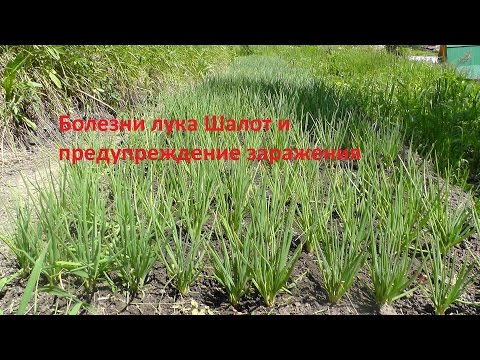

Watch this video on YouTube
Harvesting and storing shallots
It is necessary to harvest the shallots in a timely manner, as if they are in the soil for too long, they may germinate. As soon as more than ½ of the foliage is dry, you can start digging the nests. The bulbs removed from the soil are placed for several days in a shaded place for drying. Then the dried foliage is cut off, and the nests are disassembled into bulbs, which are poured into boxes, boxes or nets, and stored in a dry and cool place. If the foliage is not cut off, then weave braids from the bow. With this storage, shallots retain their qualities for 5-7 months, but do not forget to systematically inspect vegetables in order to timely remove those on which rot has appeared.
Such onions are also stored in a peeled form. To do this, the onions are peeled, cut into pieces, slightly moistened and placed in the freezer for freezing. Frozen onions are poured into plastic containers, which are put back into the freezer for storage. You can freeze shallots in the same way. This onion fully retains its qualities when frozen.
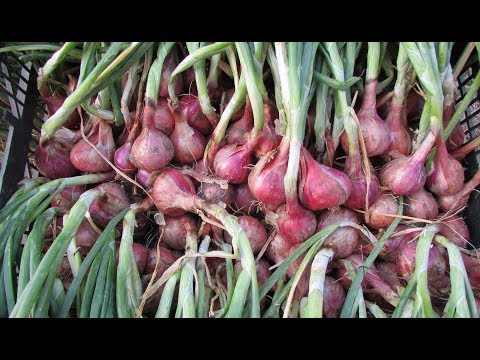

Watch this video on YouTube
Types and varieties of shallots
There are many varieties of shallots, which are divided into early ripening, medium ripening and late ripening. And the varieties are divided into sharp, semi-sharp and sweet, as well as by the number of bulbs in the nest and by the color of the covering scales.
The best early varieties
- Emerald... Round-shaped bulbs are covered with brownish-pink husk, they weigh 20-30 grams. In one nest, no more than 5 bulbs grow with peninsular white flesh.
- Snowball... This variety has excellent keeping quality. The dense egg-shaped bulbs weigh about 32 grams, the white juicy pulp has a pungent taste.
- Sprint... This onion is one of the best early maturing varieties, it is resistant to downy mildew. The taste of large onions is spicy, they weigh about 40 grams. No more than 10 bulbs grow in one nest.
- Belozerets 94... The variety is distinguished by good keeping quality and high yield. The shape of the bulbs is oval-round or round, they weigh on average from 21 to 27 grams. They are covered with a pale lilac husk with a yellowish tinge, and their flesh is a sharp juicy lilac-purple color.
- Cascade... The variety has a high yield and excellent keeping quality. Bulb bulbs weigh about 35 grams. The color of the husk and juicy pulp is pink.
- Family... The variety is highly resistant to diseases and has a semi-sharp taste. The round bulbs are covered with a brownish-yellow husk with a purple tint, they weigh about 22 grams, the flesh is white. No more than 3-4 bulbs grow in one nest.
- SIR-7... This variety has excellent keeping quality and high yield. Onions weigh about 32 grams of spicy taste. 4–7 bulbs grow in one nest.
Even among gardeners, such early-maturing varieties as: Zvezdochka, Off-season, Siberian yellow, etc. are popular.
The best varieties of medium ripening
- Albik... This sort of semi-sharp taste has a stable yield and excellent keeping quality. The shape of the bulbs is flat-rounded, and they weigh about 20-30 grams. 4-8 bulbs grow in one nest.
- Kuban yellow... This fruitful variety has a semi-sharp taste. In 1 nest, 3 or 4 bulbs of a flat-rounded shape grow, which on average weigh from 25 to 30 grams. The color of the covering scales is brownish yellow, and the juicy pulp is white or pale green.
- Koinarsky... A high-yielding variety with a semi-sharp taste. The pinkish-brown bulbs weigh about 25 grams, their flesh is light lilac with a white tint.
- Guran... The variety has a semi-sharp taste. Round-shaped bulbs weigh about 26 grams. The color of the covering scales is brownish-gray. No more than 5 bulbs grow in one nest.
- Firebird... The variety has a semi-sharp taste. Flat-rounded bulbs weigh from 25 to 30 grams, they are covered with a brownish-yellow husk.
Still quite often grown such varieties of an average ripening period, such as: Chapaevsky, Uralsky 40, Uralsky violet, Garant, Gornyak, Afonya, Adreika, Krupnolukovichny, Kushchevka Kharkovskaya, Seryozha, Sophokl, Atlas, Bonilla hybrids, etc.


Watch this video on YouTube
The best late-ripening varieties
- Kunak... The taste of this variety is semi-sharp. The bulbs are covered with yellow husks, they have a flat-rounded or rounded shape. In one nest, 3 or 4 bulbs grow.
- Sturdy... This semi-sharp variety is resistant to shooting and rotting. In one nest, 4–5 onions are formed, which can weigh 23–52 grams. They are covered with dry pink scales. The juicy flesh has a pale red color.
- Siberian amber... In one nest, 6 or 7 flat-rounded bulbs with yellow covering scales and white flesh grow. On average, the bulbs weigh about 28-30 grams.
- Merneulsky (Bargalinsky)... High yield variety. Large, elongated-oval bulbs weigh 50–90 grams. The color of dry covering scales is yellow-pink, the pulp is juicy and white. 4–6 onions are formed in one nest.
- Vonsky... The variety is resistant to diseases and harmful insects, as well as to unfavorable growing conditions. In one nest, 3 or 4 onions weighing 30–70 grams are formed, the covering scales are red, and the flesh is white.
Properties of shallots: harm and benefit
Useful properties of shallots
Shallots are very similar in composition to onions. Bulbs and foliage contain essential oil, B vitamins, carotenoids and phytoncides. But ascorbic acid, minerals and sugars in onions are less than in shallots. Such onions also contain salts of phosphorus, iron, potassium, calcium, as well as cobalt, nickel, chromium, molybdenum, silicon, vanadium, titanium and germanium.
For a long time, in alternative medicine, such a vegetable has been used to treat diseases of the eyes and stomach. In cooking, young bulbs and foliage of such a plant, both fresh and pickled, are used. Shallots have a subtler taste compared to onions, which makes them highly valued in French cuisine, they are added to soups and sauces to add flavor to them, and they are also used in game and poultry delicacies.
Contraindications
It is necessary to use shallots with caution for those who have problems with the digestive tract and the genitourinary system, as it increases acidity, which may cause irritation of the intestinal mucosa or difficulty in urinating. Still, such a vegetable should not be eaten with kidney and liver diseases, bronchospasm, constipation, pancreatic diseases, as it can provoke an exacerbation.


Watch this video on YouTube

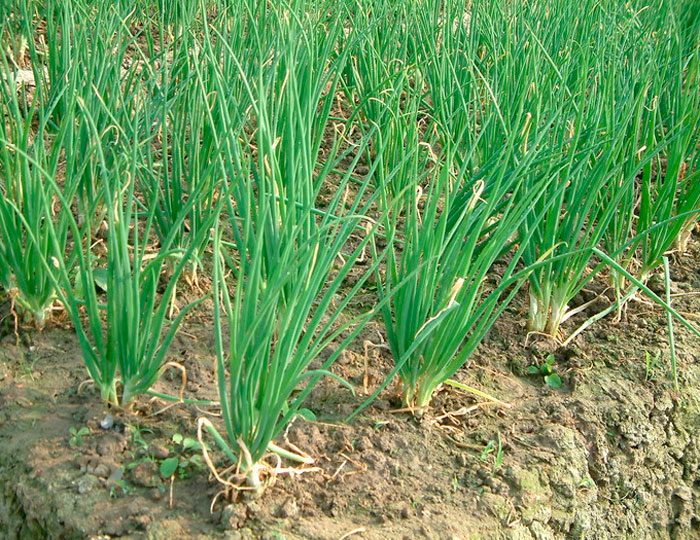
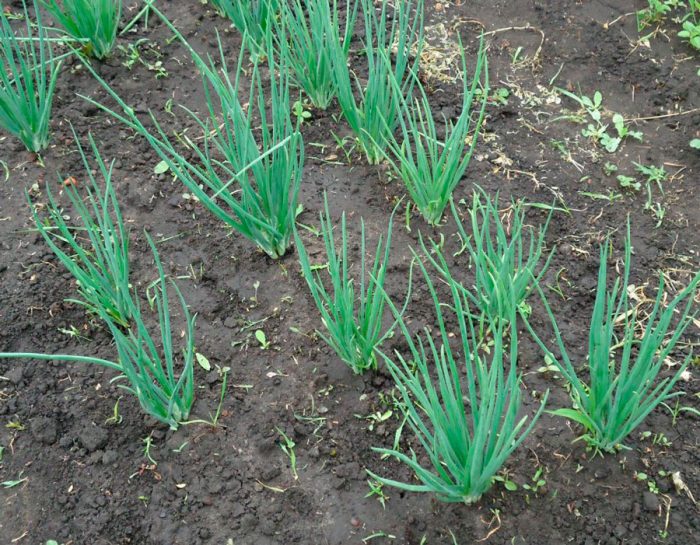
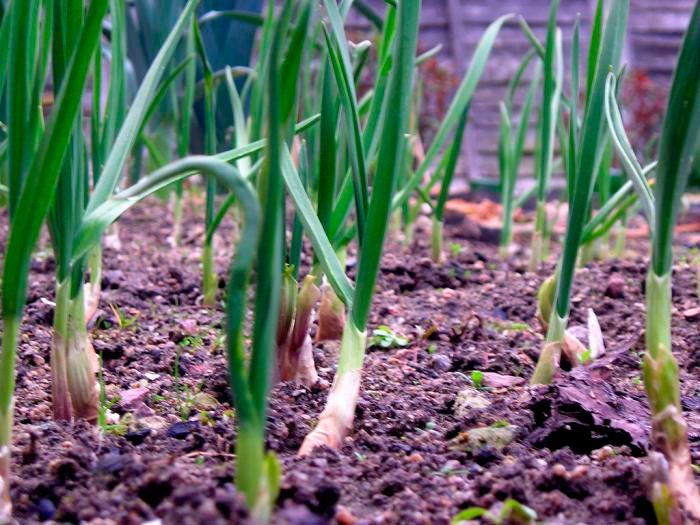
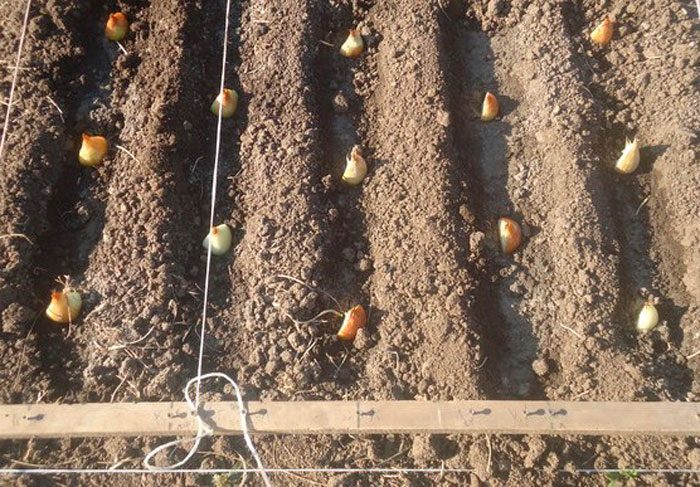
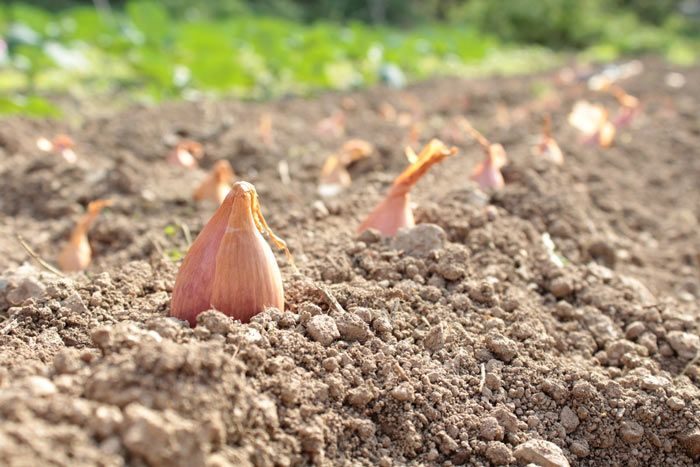
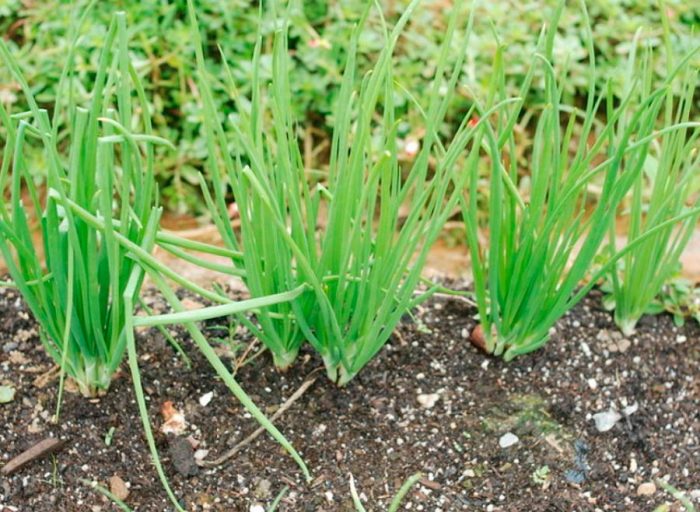
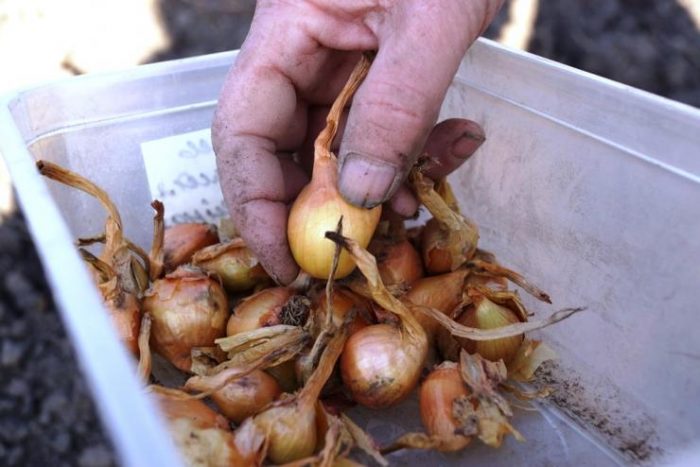
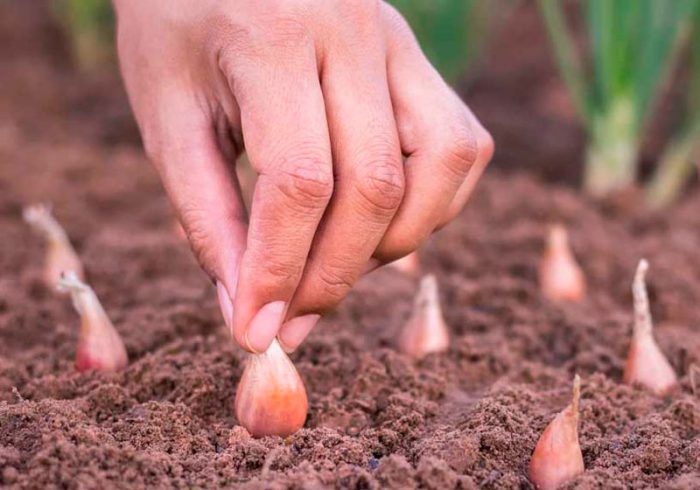
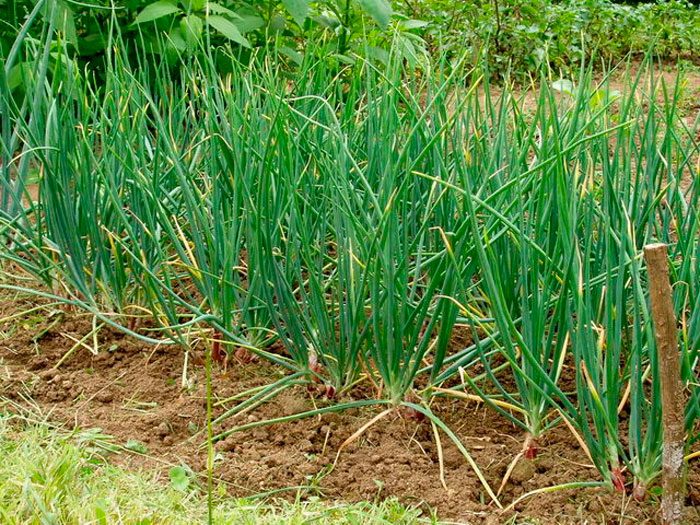
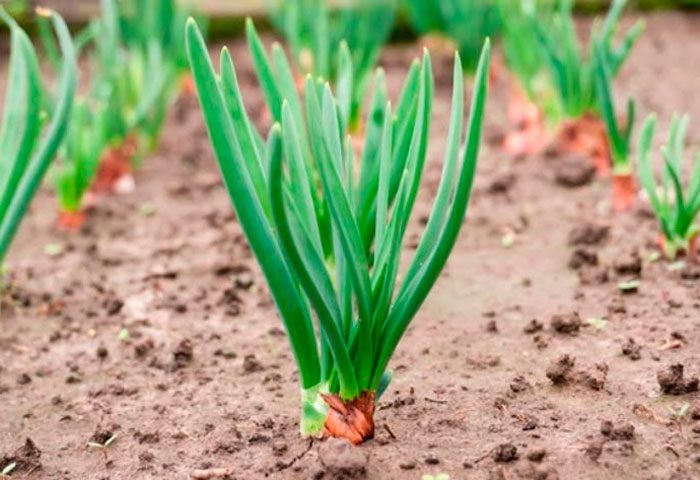
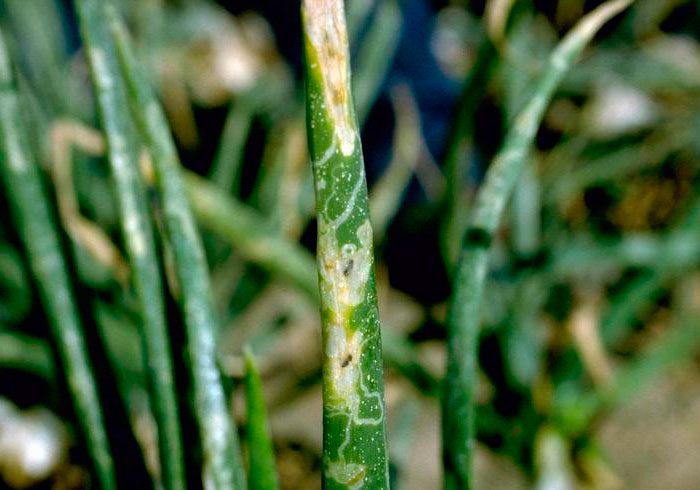
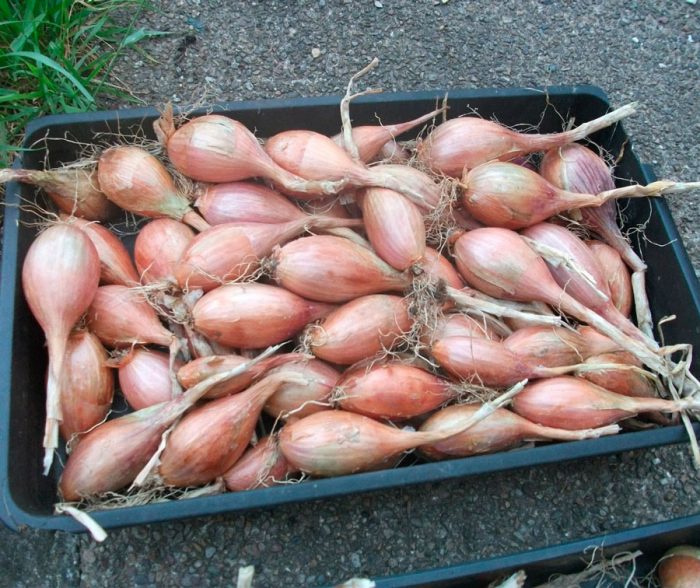
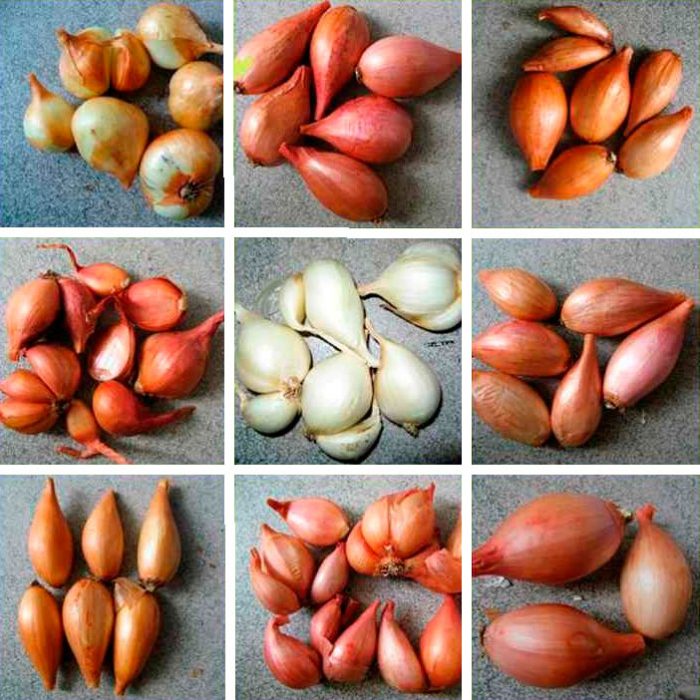
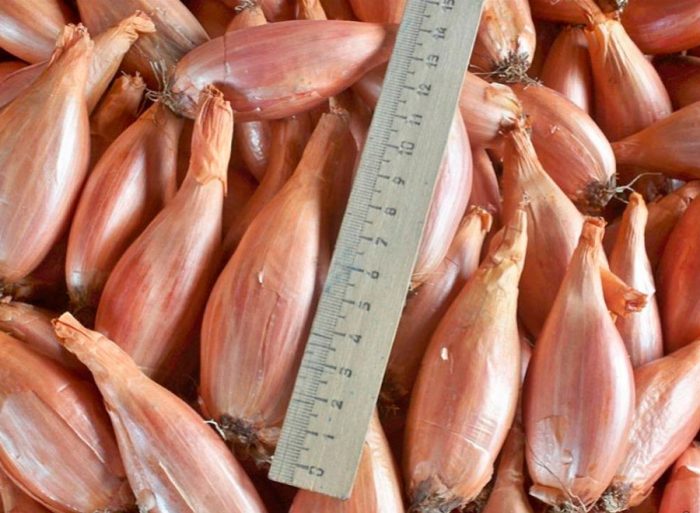
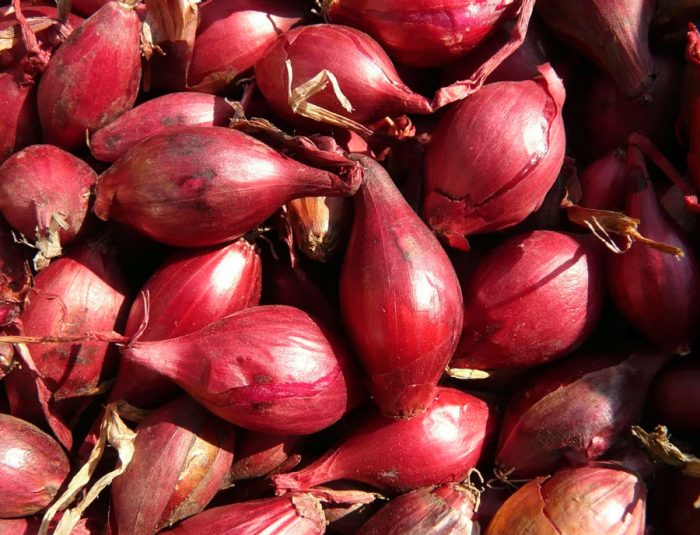
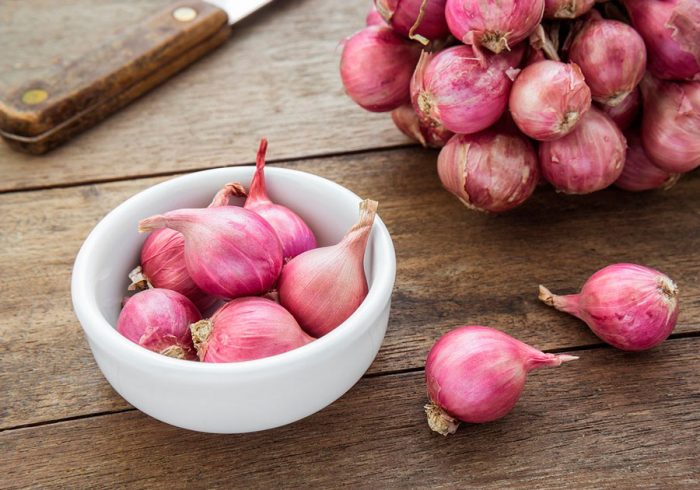

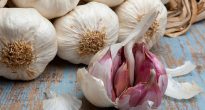

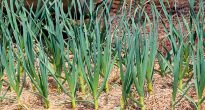

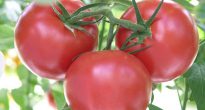




This is my favorite onion =) since we have cold weather for a long time in the Yaroslavl region, shallots appear first) and this is the most delicious onion =)